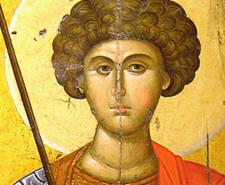
Read more about Ancient History

Lost Relics of the Knights Templar sees treasure hunters Carl Cookson and Hamilton White embark on a global odyssey. Their objective: to trace the past of a hoard of artefacts which may have once belonged to the Templars. One of their destinations is Wewelsburg, the imposing German castle which served as the spiritual sanctum for Heinrich Himmler and the SS.
Today, the castle is a looming reminder of how so many members of the Third Reich were beguiled by ancient myths, old orders of chivalry, and the occult. We all know the pantomime villain Nazis of the Indiana Jones films, desperate to dig up the Ark of the Covenant and the Holy Grail. But the fact is, many real-life Nazis were just as obsessed as their cackling silver screen counterparts.
Himmler in particular was infected by a virulent strain of spiritualism which fed into his racist, supremacist world view. For him, establishing a new Aryan empire meant resurrecting ancient Germanic myths and iconography. He believed the war against the lesser races required the overturning of traditional Christian morality, replacing it with a new kind of pseudo-religion that drew on chivalry and mysticism.
The now-notorious insignia of the SS, resembling two lightning bolts, was based on runes devised by an Austrian occultist and pagan called Guido von List. The SS itself was, in Himmler’s mind, an elite organisation in the tradition of the Teutonic Knights – an order which, like the Templars, came into existence during the Crusades. Himmler’s grand scheme was to establish Wewelsburg Castle as the Camelot of his modern-day knights. One of the rooms was even named after King Arthur, while another was designated the ‘Grail Room’.
Despite his aversion to conventional Christianity, Himmler was fascinated by the legend of the Grail, perhaps seeing it as a source of immense power. After all, he believed that another fabled artefact – Thor’s hammer – could be requisitioned as a weapon by the Third Reich. In an outlandish letter to the Ahnenerbe, a think tank set up to give academic backing to Nazi racial ideology, Himmler stated his belief that Thor’s hammer was ‘an early, highly developed war weapon of our forefathers’. For this reason, Himmler demanded that Ahnenerbe’s team should ‘find all places in the northern Germanic Aryan cultural world where an understanding of the lightning bolt, the thunderbolt, Thor's hammer, or the flying or thrown hammer exists’.
Himmler personally embarked on a failed mission to find the Holy Grail in 1940, visiting an abbey perched within the Montserrat mountain range in Catalonia. He was presumably led there by the belief that Montserrat was the real-life ‘Montsalvat’, location of the Grail in an Arthurian opera by Hitler’s favourite composer, Richard Wagner. This opera, Parsifal, was based on a medieval German poem called Parzival, written by a knight named Wolfram von Eschenbach. And this poem had already been an inspiration to another Grail hunter in the Nazi regime: Otto Rahn.
Rahn was a somewhat eccentric medievalist who believed there was a link between the story of Parzival and Catharism – a movement that flourished in medieval Europe, particularly in France. Condemned as heretics by the Catholic Church, the Cathars revived old Gnostic concepts that radically overturned traditional Christian thinking. They believed, for example, that the God of the New Testament and the God of the Old Testament were separate entities – the latter sinful, and the former good. Such ideas led to a crusade against the Cathars, and their wholesale slaughter.
A major Cathar stronghold was Montségur, a remote fortress in southwestern France. This became the site of a dramatic confrontation between the Cathars and French royal forces in 1243. Thousands of French troops besieged the fortress for nine long and gruelling months before the people inside eventually surrendered. Hundreds of Cathars were burnt alive in a bonfire after refusing to renounce their blasphemous beliefs. However, it’s believed that a number of Cathars managed to smuggle themselves out of the fortress, undetected, before their brethren surrendered.
It’s been speculated that these survivors of the siege took some kind of treasure with them. Gold, perhaps. Or maybe even the Holy Grail itself, brought back to Europe from the Holy Land, by the Templars or other Crusaders. Otto Rahn, prompted by previous occultists and mystics, identified Montségur with the ‘Montsalvat’ Grail castle of Parzival. His ideas appealed greatly to Himmler, and Rahn eventually joined the SS himself.
The extent of Rahn’s own Nazi beliefs have been a subject of debate. He himself apparently said, ‘A man has to eat. What was I supposed to do? Turn Himmler down?’ But having such powerful patronage certainly spurred him on to publish more about the Grail, with the SS brazenly inserting anti-Semitic passages into his romantic, mystical prose. Rahn eventually resigned from the SS and died of exposure on a mountain in 1939 – allegedly suicide, though the details have never been confirmed.
Colourful theories regarding the Cathars, the Grail and the potential involvement of Crusader warriors have persisted in the decades after the fall of the Third Reich. Most famously, in The Holy Blood and the Holy Grail, which theorised that the Cathars knew the secret of the Holy Grail – namely, that it was the bloodline of Christ, from the marriage of Jesus and Mary Magdalene. This concept fuelled the plot of Dan Brown’s bestseller The Da Vinci Code, which also portrays the Templars as guardians of this earth-shaking secret.
Carl Cookson and Hamilton White may not have a fabled holy relic in their hoard, but their quest may well bring new insights into the Templars and their religious treasure hunts in the Holy Land, which has fascinated everyone from eccentric occultists to high-ranking Nazis to serious historians today.